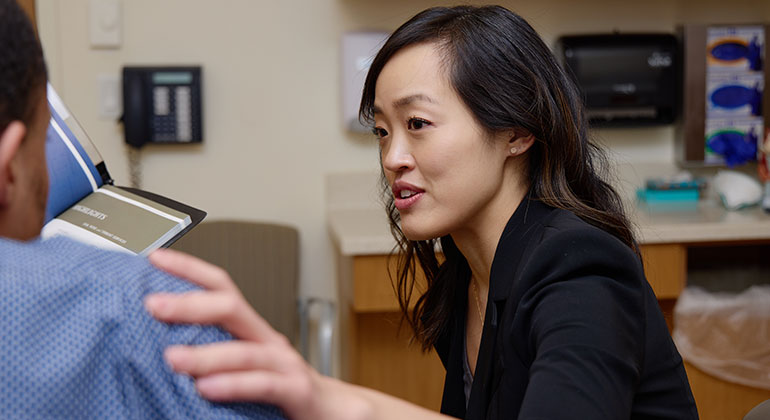Esophageal Cancer Diagnostics

Esophageal cancer is a serious condition. The two main types of this disease are squamous cell carcinoma and adenocarcinoma. Squamous cell carcinoma once represented almost 90 percent of all esophageal cancers. These days, adenocarcinoma is on the rise. It is usually caused by obesity and acid reflux. As we see more and more obesity, we also see more adenocarcinoma. It is now the most common form of esophageal cancer in the Western world. At Mount Sinai, we diagnose and treat hundreds of these cases each year.
Esophageal cancers generally affect people over age 40. It is more common in men than women. Other risk factors include smoking, heavy drinking, obesity, regular exposure to certain chemical fumes, and injury to the esophagus. Some medical conditions can lead to esophageal cancer. These include acid reflux, Barrett’s esophagus, human papilloma virus (HPV), achalasia, tylosis, and Plummer-Vinson syndrome. More Caucasians get the disease than any other race, but rates among African Americans are rising. American Indians, Latinos, and Asians/Pacific Islanders have lower rates of esophageal cancer.
Symptoms of esophageal cancer include:
- Chest and back pain
- Hoarse voice or cough lasting more than two weeks
- Pain when swallowing
- Persistent heartburn
- Sensation of food getting stuck or coming back into the throat
- Unanticipated weight loss
Early Detection
Early detection and treatment are vital to treating esophageal cancer. At Mount Sinai, we use a variety of diagnostic tests. These include:
- Barium swallow (upper GI series): After you drink a liquid with barium to coat the inside of your esophagus, we take a series of X-rays. These help us see any ulcers, scar tissue, abnormal growths, hernias, or areas that block food as it travels through the digestive system.
- Biopsy: We collect a small piece of esophageal tissue through an endoscope. Then we examine it under a microscope for cancer cells, tissue changes, or other conditions.
- Bone Scan: Lets us identify anything unusual about the bone. We can see metastatic tumors, infections, and fractures. These scans use radioactive isotope technology to detect changes in your bone metabolism.
- Chest X-ray: Allows us to see your lungs, heart, and surrounding tissue.
- Computed tomography (CT) scan: A type of X-ray that gives us pictures of structures inside your body. The computer analyzes these data to construct a 3D image.
- Confocal microendoscopy: We sedate you for this 10-minute, state-of-the-art procedure. Then, we insert a narrow tube with a microscope on the end into your esophagus. This gives us standard images as well as views that we can normally only get with a microscope. We can see any cancer, precancer, or infection cells without taking a biopsy.
- Endoscopy (or esophagoscopy): We examine the inside of the esophagus with a thin tube. This tube, called an endoscope, has a camera on the end. If we find an abnormal area, we collect tissue for further study in the lab.
- Endoscopic Ultrasound: Using a narrow flexible tube with an ultrasound probe at the end, we assess the depth of the tumor. We can also evaluate your lymph nodes. If necessary, we can collect tissue to perform a biopsy.
- Positron emission tomography (PET) scan: Using glucose to mark cells, this scan identifies cells with unusually high activity. Such cells are often tumors or infections. We use PET scans to help us stage esophageal cancer.